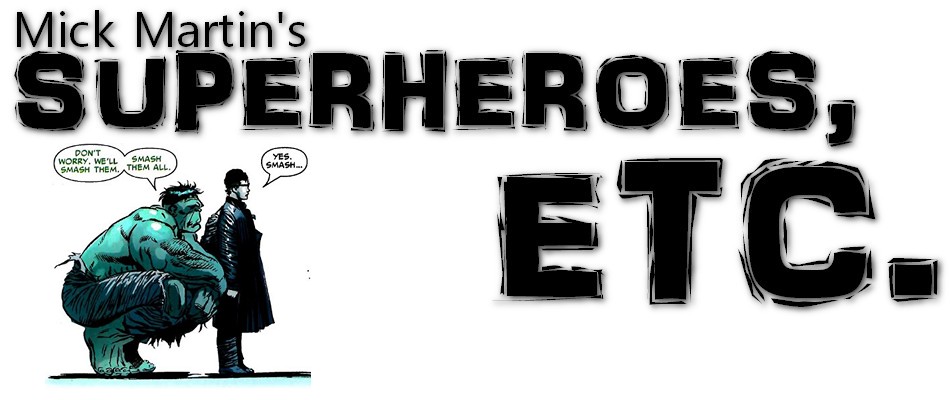 Essential Super-Villain Team-Up
Essential Super-Villain Team-UpVarious writers and artists
Published by Marvel Comics; $16.99 US
Ed Brubaker's upcoming Books of Doom won't be the first series to see Marvel's premiere bad guy - Doctor Doom - as a protagonist. Adding to Marvel's long list of popular Essential collections is Essential Super-Villain Team-Up, collecting the short-lived mid-70's series Super-Villain Team-Up along with the series' two "Giant-Size" prequels, Doom's solo stories from Astonishing Tales, a few issues of Avengers, and the second-to-last issue of Champions.
Before exploring this collection it's important to understand that the title of the comic is misleading on three fronts. First, Super-Villain Team-Up is not - as you might expect - the darker half of the current or previous volumes of the more heroic Marvel Team-Up. MTU's current incarnation features different line-ups every issue or few issues, while its previous volumes usually featured one main character with rotating peripheral heroes. The bulk of SVTU featured only Doom and Sub-Mariner (thirteen of the seventeen issues, plus both Giant-Size prequels), with other characters hurried in at the end of the series. Second, the phrase "Team-Up" in this case seems to mean no more than "these characters show up in the same issue." The villains "teaming up" are more likely to be beating the hell out of each other than working towards a common goal. Third, while you can bicker back and forth about whether or not Sub-Mariner could be definitively called a "superhero," by 1975 - after being featured as a hero in both Tales to Astonish and his own series, as well as regularly appearing in Defenders - it's debatable whether he could reasonably be called a super-villain. The latter point might seem nitpicky at first, but it's indicative of how the book fails to live up to the title.
The collection begins with the Astonishing Tales reprints, featuring a number of conflicts that become relevant later in the SVTU chapters. One of the most memorable of these brief tales is something of a prequel to the Stern/Mignola graphic novel, Doctor Strange and Doctor Doom: Triumph and Torment, focusing on the villain's endless attempts to free his mother's soul from the underworld. Most of the following stories give us Doom and Namor in a hate/really-really-hate relationship. First they attempt to woo one another into a world-conquering alliance, eventually Doom shifts from wooing Fish-Man to enslaving him, and there's a lot of fisticuffs in-between. It's the longest and most engaging piece of the collection, and the only thing that comes close to living up to Marvel's advertisement of it as a "war epic." After the Doom/Namor saga comes a silly contest between Doom and Magneto that crosses over into Champions. The collection ends with a complete shift in the storyline, replacing Doom with the Red Skull and his brother-in-supremacy The Hate Monger.
If there is any all-encompassing failure of Super-Villain Team-Up, it's that the folks handling the series were never sure what they wanted it to be. The direction takes a sharp turn after the chapter reprinting SVTU #3. The chapter ends with Doom and Namor in an uneasy alliance, while the beginning of SVTU #4 has them uttering the same or similar phrases they calmly spoke at the end of the third issue, but this time yelling them with balled fists and eventually attacking each other. Whether it was because the folks in the Bullpen caught a sudden strain of timidity when realizing the series was making a promise they couldn't make good on (villains-as-protagonists in a story of world domination set in a cooperative universe), Namor fans spoke out angrily about the idea of their favorite hero shaking hands with the monarch of Latveria, or it had more to do with behind-the-scenes politics than questions of story, the SVTU creative team realized they had a concept too interesting to see it through to the bitter end.
Instead of an epic of villainous world domination, SVTU gives readers a confusing dance between Doom and Namor. Doom constantly attempts to trick or blackmail Namor into becoming his ally without any indication of why the aquatic prince is at all important to him. The pair fight off attacks by heroes and villains alike, but there's never any sense that either have plans of their own. The schemers aren't scheming. They just fly around and punch stuff.
The tacked on Red Skull/Hate Monger two-parter is more true to the concept of villains-as-protagonist, but lacks the epic scope of the Doom/Namor story. And, since it's the end of the series, it's too late and too brief to seem like anything but a final hiccup.
It's a flawed tale though not without its share of good ol' super-stompin' fun. There's lots of great art by folks like Gene Colan, Sal Buscema, Herb Trimpe, and George Perez; superhero-fisticuff fans will spooge their jeans over the Champions reprint that features a battle royale between Doom, Magneto, the Beast, the Champions, and the Hulk; and if you're like me and just enjoy Doctor Doom's silly tirades, it's not tough to get engrossed in the trade. If that's good enough for you, check it out. Just don't expect the super-villains to be very villainous.

No comments:
Post a Comment